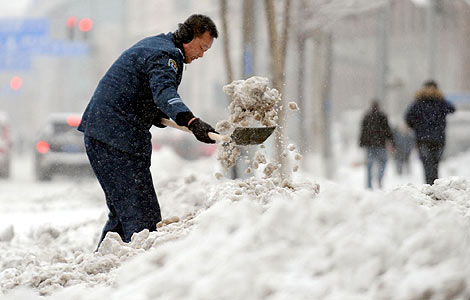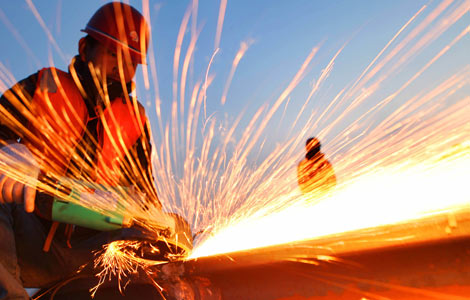
China's Qinghai-Tibet Railway, the world's highest rail system, is being threatened by desertification on the Qinghai-Tibet Plateau as a result of global warming, experts concluded after conducting a probe.
About 443 km of the 1,956-km railway are in areas affected by desertification, including 103 km that lie in seriously desertified areas, Wang Jinchang, a senior engineer with the Qinghai-Tibet Railway Co, said on Monday.
Wang cited research showing that the threat of soil erosion grew very fast in recent years, mostly near rivers and wetland from Golmud and Lhasa, and the amount of affected track almost doubled from 2003 to 2009.
Touted the "Road to Heaven", half of the Qinghai-Tibet Railway was built on areas at an elevation of about 4,000 meters, crossing mountains, ravines, the Gobi Desert and frozen earth, among other hostile environments.
An Fengjie, an official with China's State Forestry Administration who specializes in soil erosion control, said the plateau region suffered from desertification long before the railway was built.
"The railway did not cause the problem, but it gives us an opportunity to witness the severity and scale of soil-erosion on the Qinghai-Tibet Plateau," An said.
Sands buried tracks and disrupted train services more than 1,362 times from 1984 to 2002 on the Xining-Golmud section of the railway, which has been operating since 1984. The main part, the Golmud-Lhasa section, went into operation in 2006.
Since becoming fully operational, the railway has transported 52.76 million passengers, according to the railway company's estimate this month. Work has begun to expand the railway from Lhasa to Xigaze, a historical Tibetan city and home to the Panchen Lamas.
Engineers set up barrier walls or simply placed big rocks along the tracks in affected areas to prevent sands from encroaching on the rails.
"These emergency control measures have been effective, but we still need to address the root problems of desertification," An said.
One of the most prevalent theories blames global warming for ecological deterioration in the plateau region.
Sun Zhizhong, a researcher with the Chinese Academy of Sciences, said temperatures on the Qinghai-Tibet Plateau rose by more than 2 C on average over the past three years, leaving large chunks of frozen earth to defrosting.
The moisture is soon lost, however, as water quickly evaporates under the plateau's blazing sun. The soil begins to dry up and eventually becomes desert, Sun explained.
He said overgrazing is another concern.
"Lab results tell us that desertification is a trend that will be hard to reverse in the near future. The Qinghai-Tibet Plateau may one day become a major source of sandstorms," said Qu Jianjun, another researcher with the Chinese Academy of Sciences.
Qu said glaciers are also melting quickly on the plateau. More than 200 small glaciers in the region have disappeared over the past five decades. Lakes in the heart of the Hoh Xil Nature Reserve, home to 70,000 Tibetan antelopes in remote western Qinghai, have become swollen as a result of melting glaciers and snow.
Xiao Penghu, deputy chief of the nature reserve administration, described melting glaciers as "a hanging dagger".
He said that after most glaciers melt away, the lakes and rivers in the Hoh Xil region will start to dry out, resulting in "disastrous" consequences for the local ecology.
"The fate of the Tibetan antelopes is in our hands, because our actions set the pace of global warming," said Tseten, another official with the nature reserve, calling for people around the world to unite to fight climate change.
"Once global warming wipes out (Tibetan antelopes), we'll eventually be wiped out as well," he said.







